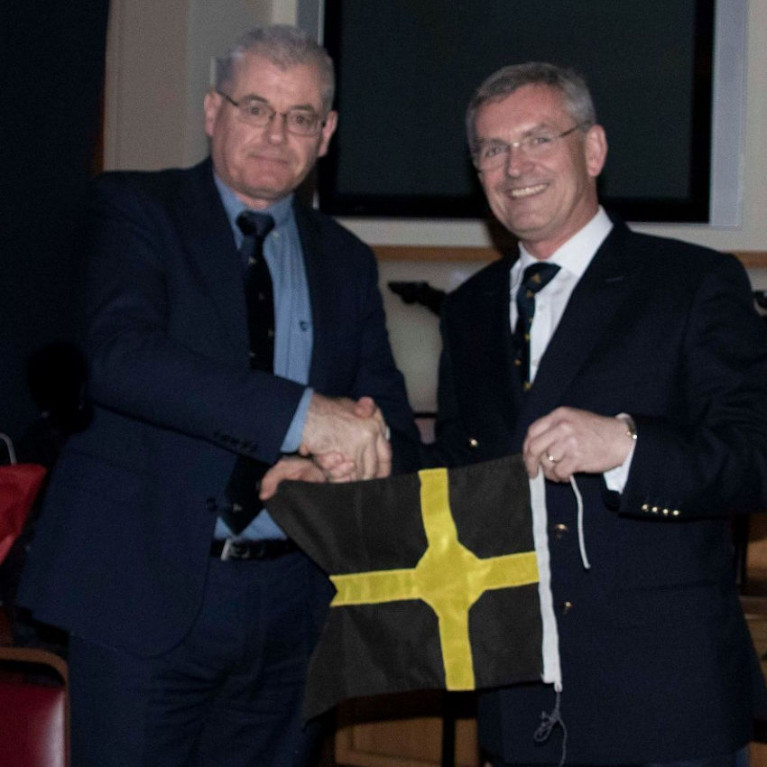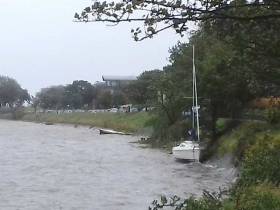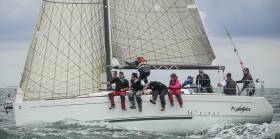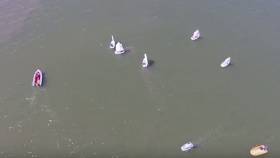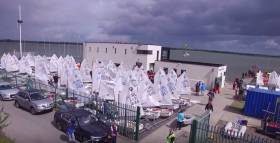Displaying items by tag: Malahide Yacht Club
RYA Day Skipper Certificate for Young Malahide Sailor
A 16-year-old Malahide Yacht Club cadet has become one of the youngest sailors to be awarded the RYA Day Skipper (Sail & Power Craft) and ICC Certificate.
Daniel Flavin, a Transition Year student at the local Community School, was assessed on all aspects of this demanding and challenging course and successfully passed all the practical and theory modules to earn the qualification.
He is the eldest son of the MYC Commodore Daniel Flavin Snr., while his mother Therese is the Club's Junior Affairs Officer and Centre Principal of the Club's Dinghy Sailing Centre at Broadmeadows.
Having begun his sailing at the tender age of 1, and with more than 2,000 miles logged to date, Daniel hopes his achievement will inspire more MYC cadet members. In the past couple of years, the arrival of three J/24s to the MYC Cruiser fleet provides a great stepping-stone for the Club's young members to start their keelboat sailing careers.
Malahide Yacht Club’s New Commodore Promises Bigger & Better In 2020
Malahide Yacht Club’s new commodore Daniel Flavin promises continued expansion of the north Co Dublin club’s training and development programme in the year ahead.
In addition, moves to improve facilities at both clubhouses will be part of an overall work plan being prepared alongside an ambitious sailing calendar for 2020, with further announcements to come at the club’s launching supper at a future date.
Celebrating the community spirit of the club’s strong social network, Commodore Flavin called on members who have not yet had the chance to rig out their boat, go for a sail or attend its events to get involved this year.
Commodore Flavin’s full address is included in the latest MYC newsletter, which also has information on junior and adult training courses, the upcoming events schedule and details of the new online membership renewals system.
Great Club Effort to Rescue Malahide Yacht
The spirit of Malahide Yacht Club (MYC) is very much alive and kicking after a big effort by a large team of volunteers help pull a club member's boat off the southern side of the Lower Estuary.
The boat had broken its moorings in the high winds and needed to be re-floated on the next high tide and then towed into the marina, especially with the prospect of Hurricane Lorenzo expected to hit us soon. The operation involved about a dozen MYC members.
Malahide 24–Hour Sail Raises Over €2,000
A 24-hour sail raised over €2,000 for the Ocean Cleanup organised by DCU and DIT sailing teams in Malahide Yacht Club.
The event called ‘DCU x DIT 24hr Sail’ consisted of the same two Topaz boats crewed by teams of two sailed from 5pm on 25th October to 5pm the next day.
"The event has gone from strength to strength each year” said Aaron Jones, Captain of the DCU Sailing Team, “the addition of DIT this year was a huge benefit to the cause and definitely helped us smash our goal of €1,500”.
“By joining the college’s together it greatly helped advertise the event and helped spread awareness to such an important issue facing out generation” said Louis Tate member of DIT Sailing who helped organise the event.
A huge network of support and shift work meant the same two boats were on the water for 24 hours while other land and water activities took place. Talks were given to junior and senior members of MYC on our sailor’s experiences including the Round Ireland Race, Olympic Sailing and team racing.
With winds reaching close to 30 knots at times, safety was always a priority, especially during the night time sailing. Certain measures were taken to ensure this including the decision to hold the event in Malahide’s closed estuary.
“I know the estuary inside out where you can sail safe, where you can stand and the fact it’s enclosed so if an issue arises you won’t get lost and can sail towards land in any direction you go” said Colm Roche, recent DCU graduate and instructor at MYC.
The boats were also equipped with a VHF each, PDFs, hi-visibility jackets, appropriate weather gear, lights and were constantly accompanied by a team on a powerboat.
The event finished with a raffle with prizes from some of the sponsors including Camille, SuperValu, Jamie Knox and DCU Surf N’Sail.
While the success of the event comes down to those in DCU and DIT organising it and those involved on the day, Colm Roche also feels it’s important to recognise his club’s contribution “when a club gives you so much you want to give something back”.
The event raised €2,294 through online and on the day donations but you can still donate to the Ocean Cleanup, a non-profit organisation developing technologies to rid the world’s oceans of plastic. It is estimated they will clean up half the Great Pacific Garbage Patch in 5 years.
You can donate through this link here
17 Fevas For Greystones Sailing Club Coaching Session
17 RS Feva dinghies participated in the latest round of coaching for the class at Greystones Sailing Club at the weekend writes Garett Donnelly. Conditions were perfect with coaching provided for all the sailors ranging in age from 11 to 17 years of age.
Sailors from Greystones, RStGYC, RIYC, Bray SC, Malahide YC and Howth YC took part.
Next up on the Feva 2017 calendar is coaching in Malahide Yacht Club from 8th to 10th April and then Howth Yacht Club for coaching on 19,20,21.
The Eastern Championships follow on 22 and 23 April. Entry for the Easterns is here.
Malahide 420 Sisters Cara & Gemma McDowell Off to Flying Start at World Championships
Wind finally arrived this afternoon at the 2016 420 Worlds in Sanremo, Italy. All three fleets, open, ladies and under 17, completed three races before the wind dropped again.
Malahide YC sisters Cara and Gemma McDowell set a high standard for the 7-boat Irish team with a second in race one, finishing the day in seventh overall.
Howth YC pairing Douglas Elmes and Colin O'Sullivan got off to a good start with an eighth in race one ending the day in 11th place.
Howth Yacht Club's Big Turnout for Gibney Classic Race
Strong winds only added to the enjoymen in this year's Howth Yacht Club Gibney Classic on Saturday writes Brian Turvey. One of the largest cruiser–racer fleets in many years contested this always anticipated annual event, where the race itself is matched by the wonderful hospitality shown by Tony and Barry Gibney in their famous hostelry in Malahide, with a barbecue and drinks reception for the many exhilarated and weather-beaten sailors.
The race was run by Susan Cummins and her team on board the Sea Wych in conditions that might be described as 'fresh' by some and 'challenging' for all. A consistent 20 knot south-westerly prevailed over the racecourse with gusts ready to flatten boats sailed by even the most experienced helms and trimmers. It was a day for fully-crewed keelboats, with lots of weight 'on the rail'.
After an hour's racing, the ever-competitive Class 2 saw the Bourke/McGirr/Ball owned X332 'Xebec' win on IRC and David Sargent and his team on his Elan 33 'Indulgence' win the ECHO prize. Class 3 was evenly competed by boats from Howth and Malahide with Vince Gaffney winning IRC on his 'Alliance II' and Brian McDowell winning ECHO on his J24 'Blue Jay'.
Fifteen boats entered the Non-Spinnaker class which certainly provided the majority of thirsty customers in the beer garden and sports bar after racing. Paddy Gregory and Don Breen's decision to enter their First 34.7 'Flashback' in the class proved a wise one and they took the IRC prize while Michael Fleming's 'Trinculo' took the ECHO honours.
The Howth 17s have made this event an important part of their calendar for the past few years and the strong winds didn't deter their determination to enjoy the day, with four boats sailing up the river into Malahide after racing and returning to Howth later in the evening (into a warm 30-knot southerly). First prize went to Turvey brothers Brian and Conor in their 17 'Isobel'. The handicap spoils were won by Bryan and Harriette Lynch in 'Echo'.
Hats off to MYC's Commodore Deidre Moore-Somers who organised the rescheduling of another event so that the MYC boats could take part. Their annual regatta follows in 2 weeks on the 23rd of July. Special thanks also to Maureen Muir who again did all the organising for the club and with the team at Gibneys.
Eleven teams of four sailors each took part in the IODAI–organised Optimist event on Friday 1st July at Malahide Yacht Club. Royal Cork Yacht Club and Monkstown Bay Sailing Club were well represented with five teams. The sailors completed 25 races in the group stages in very changeable but warm four knots to 30 knots, bright sunshine to heavy rain.
After two round robin flights, RCYC Pumas, Jaguars and Panthers teams were eliminated with MBSC Panthers being particularly unlucky, losing on count-back to a Royal St George team.
In the semi-final, RCYC Leopards were pitted against RCYC Cheetahs, ensuring one Cork team made it through to the final. The former won through and met the RStGYC counterparts who sailed well to even up the best of 5 series 1/1. In the third race, RCYC won narrowly in quite squally conditions but in the fourth race, with much less wind, Royal Cork proved quicker and comfortably won.
The Leopards, captained by Harry Twomey, with Diego and Alexandra Peletiero and Michael Crosbie, successfully defended the V-P trophy they won last year.
The Optimist Ulster Championships, hosted by Malahide Yacht Club, saw 120 young sailors compete on the Broadmeadow Water in mixed conditions over two days, with the honours in the Gold Fleets at both Senior and Junior levels going to Royal Cork YC entries.
The event, sponsored by the Grand Hotel, saw Harry Pritchard of RCYC sail consistently throughout to beat clubmate Harry Twomey by just 3 points in the Senior Gold fleet while two other Cork sailors, Michael Crosbie and Justin Lucas, headed up the Junior Gold fleet.
National Yacht’s Club’s Nathan van Steenberge and Jacque Murphy (RStGYC) won the Senior and Junior Silver fleets respectively.
The first day’s racing was notable for fresh westerly and south-westerly winds, with several heavy gusts which severely tested the sailors’ abilities. Conditions improved on the second day and PRO Neil Murphy was able to complete a full 6-race schedule.
New Dinghies, Sails For Malahide Yacht Club Thanks To Capital Grant
#MalahideYC - Malahide Yacht Club has put its Sports Capital Grant allocation to good use with the purchase of new dinghies and sails.
According to the Swords Gazette, the €44,000 grant was used to procure six new sailing dinghies, two windsurfing boards and rigs, and assorted sails for the club's fleet based at Broadmeadows.
The new dinghies will be used for adult and junior sail training, introductory courses for locals, and of course club racing.


























